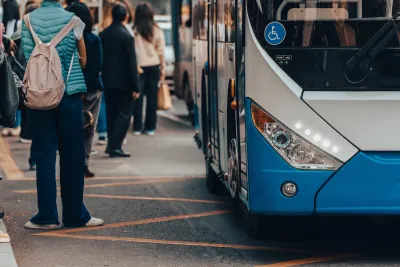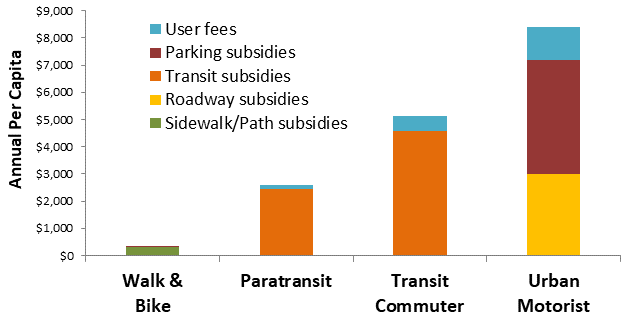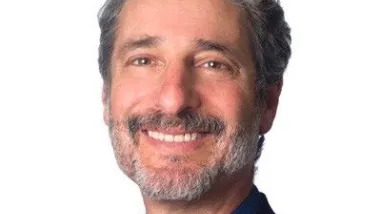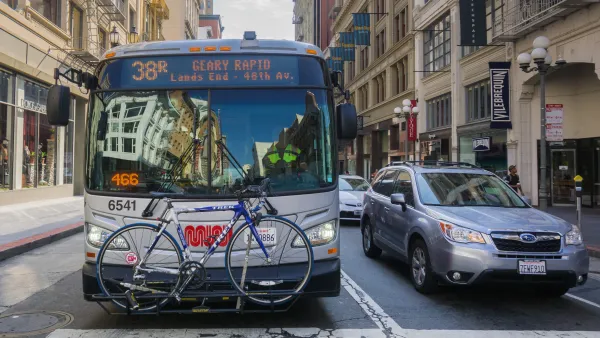Public transit plays a unique and important role in an efficient and equitable transportation system. Planners must communicate the benefits that public transit provides and respond to ill-informed critics.

Public transportation is taking a beating these days. Ridership plummeted during the pandemic; it is recovering in some but not all communities. Some transit vehicles and stations have become refuges for people who are homeless and drug-addicted, making them feel unsafe and unattractive. Costs, including labor, construction, and vehicle costs, have risen substantially in recent years, and many transit agencies are having trouble recruiting qualified workers. In addition, transit has been sucked into nasty culture wars based on the assumption that “collectivist” public transit conflicts with American individualism. Transit planners and advocates need tools for building the business case for increasing investments and providing other support to improve and encourage public transit travel.
Critics point out that public transit serves only about 5 percent of commute trips and about 3 percent of total trips, which is much smaller than the portion of transportation budgets devoted to transit service. Critics also argue that public transit is more costly and receives more public subsidy than driving. For example, the APTA Transit Fact Book indicates that in 2020, public transit costs totaled about $50.5 billion — of which fares only covered about $9.1 billion — and provided about 33 billion passenger miles of travel, indicating that public transit costs about $1.53 per passenger mile, with public subsidies making up about 82 percent or $1.25 per passenger mile. In contrast, they claim that motorists pay for highways through fuel taxes and tolls, or at most receive modest subsidies when they use locally funded roads. The FHWA’s Highway Statistics Report indicates that in 2020 governments collected about $141 billion in vehicle fuel taxes and tolls and spent about $266 billion on roadways, which served about 3,132 billion vehicle miles, indicating that vehicle travel costs averaged just 8.5 cents per vehicle mile — of which just over half (4.5-cents per vehicle-mile) is funded by general taxes. That suggests that public transit costs about 18 times as much and receives 28 times greater subsidy than automobile travel.
This analysis is incomplete and unfair. Below are additional factors to consider when comparing public transit and automobile costs.
First, it is important to recognize that public transit is intended to provide two very different and often conflicting goals: efficient urban mobility and basic motility for non-drivers. Efficient urban mobility requires high-quality service on dense travel corridors where any form of vehicle travel is particularly costly. This justifies subway and bus rapid transit systems, which are costly to build but generally far cheaper than the total costs of expanding roads and providing parking facilities for driving in those areas. In contrast, basic mobility requires providing services at times and places with low ridership, such as buses operating late at night and in suburban areas. Because of these conflicting goals, efficiently-oriented service may seem inequitable (it requires high-quality services that attract travelers who would otherwise drive) while basic mobility-oriented service may seem inefficient (it has high costs per passenger mile).
Second, automobile travel receives other subsidies, particularly government-mandated parking subsidies, and imposes other external costs. My research indicates that in a typical community, there are three to six off-street parking spaces per motor vehicle (one at home, one at the worksite, and others at various destinations, including many that are seldom or never used but mandated by governments. Considering land, construction, and operating expenses, their annualized costs range from about $800 for basic service parking on inexpensive land to more than $4,000 for high-amenity structured and underground parking. This totals $2,000 to $4,000 annually per vehicle, or $0.60 to $1.20 per vehicle mile. Automobile travel imposes other external costs including congestion delays, crash risk, and pollution damages imposed on other people.
Third, people who depend on transit travel far fewer annual miles than motorists, so even if their per-mile costs are higher than driving, their per-person annual costs are much lower. A typical daily transit commuter travels ten miles each workday, or about 2,250 annual passenger miles, about a fifth of the 12,000 annual miles that a typical motorist drives.
Fourth, a major portion of public transit services operate in denser cities where expanding roads and increasing parking supply is particularly costly, and the congestion, safety risks, and pollution costs of automobile travel are particularly high. As a result, urban transit costs should be compared with these very high costs of accommodating more urban automobile travel.
Comparing Urban Infrastructure Costs

Fifth, for transit that provides basic mobility for non-drivers, which includes most service at times and locations with low ridership, plus the additional costs of features such as wheelchair lifts, station elevators, and on-demand paratransit services, the alternative is either paying a taxi or ride-hail trip, or a family member or friend driving bearing the time and vehicle operating costs of chauffeuring. Such trips are particularly inefficient since they usually generate empty backhauls (travel empty to pick up or drop off a passenger) so a five-mile bus trip often substitutes for a ten-mile chauffeured trip. For these trips, which probably generate half or more of total transit costs, transit subsidies are generally much lower than what would be required to serve those trips by taxi or chauffeuring.
Sixth, public transit travel has high fixed and low marginal costs. Excepting under urban-peak conditions, most public transit vehicles have excess capacity so the costs of accommodating additional passengers are small. As a result of this cost structure, transit service becomes more efficient — its cost per passenger mile declines — as ridership increases. For this reason, anybody who is truly concerned about the high unit costs of public transit should advocate for more transit subsidies, plus TDM incentives to increase ridership to take advantage of unused capacity and create the virtuous cycle of more ridership, more service, and more public support.
Seventh, high-quality public transit can be a catalyst for more compact, multimodal development, which can provide large financial savings and increase economic productivity. These are benefits that are often ignored in conventional transportation economic evaluations.
In summary, although public transit services indeed have higher government costs per passenger mile, their costs are generally lower than the total costs of accommodating more urban-peak automobile traffic, including the costs of expanding roads and parking facilities, plus the additional delays, risk and pollution damages they impose on other people. Because they travel fewer annual miles than most motorists, transit commuters receive less total infrastructure subsidy than automobile commuters. Public transit becomes more efficient as ridership increases, which justifies incentives to encourage more use. When all impacts are considered, improving public transit and giving travelers more incentive to use that service is often the most cost-effective, fair and beneficial way to improve transportation.
Public transit plays a unique and important role in an efficient and equitable transportation system. Current demographic and economic trends — an aging population, high fuel prices, increasing urbanization, changing consumer preferences, and increasing health and environmental concerns — are all increasing future demands for public transit and the benefits to users and society of improving and encouraging public transit.
The challenge for planners and advocates is to quantify and communicate the large and diverse benefits of improving and encouraging public transit services and to articulately respond to ill-informed critics.
For more information
Yonah Freemark (2022), “What Would Providing Every City with High-Quality, Zero-Emissions Public Transportation Look Like?,” Urban Wire.
Todd Litman (2017), Evaluating Public Transit Criticism, Victoria Transport Policy Institute.
Todd Litman (2020), Raise My Taxes, Please! Evaluating Household Savings From High Quality Public Transit Service, Victoria Transport Policy Institute.
Todd Litman (2023), Fair Share Transportation Planning, Victoria Transport Policy Institute.
Todd Litman (2024), Evaluating Public Transport Benefits and Costs, Victoria Transport Policy Institute.
Jarrett Walker (2012), Human Transit: How Clearer Thinking about Public Transit Can Enrich Our Communities and Our Lives, Island Press; blog at www.humantransit.org.

National Parks Layoffs Will Cause Communities to Lose Billions
Thousands of essential park workers were laid off this week, just before the busy spring break season.

Retro-silient?: America’s First “Eco-burb,” The Woodlands Turns 50
A master-planned community north of Houston offers lessons on green infrastructure and resilient design, but falls short of its founder’s lofty affordability and walkability goals.

Delivering for America Plan Will Downgrade Mail Service in at Least 49.5 Percent of Zip Codes
Republican and Democrat lawmakers criticize the plan for its disproportionate negative impact on rural communities.

Test News Post 1
This is a summary

Test News Headline 46
Test for the image on the front page.

Balancing Bombs and Butterflies: How the National Guard Protects a Rare Species
The National Guard at Fort Indiantown Gap uses GIS technology and land management strategies to balance military training with conservation efforts, ensuring the survival of the rare eastern regal fritillary butterfly.
Urban Design for Planners 1: Software Tools
This six-course series explores essential urban design concepts using open source software and equips planners with the tools they need to participate fully in the urban design process.
Planning for Universal Design
Learn the tools for implementing Universal Design in planning regulations.
EMC Planning Group, Inc.
Planetizen
Planetizen
Mpact (formerly Rail~Volution)
Great Falls Development Authority, Inc.
HUDs Office of Policy Development and Research
NYU Wagner Graduate School of Public Service






























